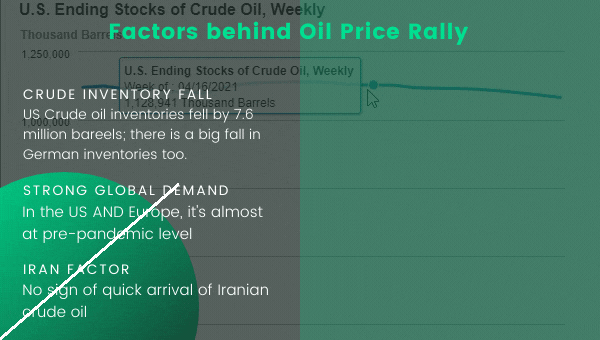The gradual rise in price of crude oil continues on Thursday,
further buoyed by the latest data from the EIA, indicating a sharp drop in US
crude inventories.
In fact, the drop exceeded analysts’ expectations. It
means the recovery of demand is on track and irreversible with the engine of
growth steaming ahead.
On Wednesday, Brent crude and WTI crude rose by 0.5% and 0.3% respectively. Both benchmarks rose by 0.1% again in the early hours on Thursday, reflecting the strength of the market.
The two benchmarks recorded the highest since
October, 2018.
The upward momentum is so strong that even the news
about certain sanctions being lifted against Iran, first reported by the
Iranians only to be denied by the US later, did not buckle the trend.
The EIA, US Energy Information Administration,
reported that the fall of US crude oil inventories in the week to June was 7.6
million barrels; the predictions by analysts, based on the secondary data, were
far below this value; it also shows that some crucial information still evades
the radar of analysts, despite the leaps in technological advances such as ML.
It was not just crude inventories that fell during this period; gasoline stocks fell by 2.9 million barrels in the week, giving the sector the much-needed consistence.
The rise is also attributed to the acclerated growth figures and the demand in fuel in proportion to the former from Europe's powerhouse, Germany; it is the highest rate since the German reunification, according to the latest reports.
There are certain issues that still haunt the crude oil markets, though.
India, for instance, the world’s third largest oil
consumer, appears to be out of the woods, the steep rise in oil price could
potentially backfire on the feeble growth; the emergence of a new variant of
the Coronavirus, dubbed Delta+, is a cause for concern too.
In the rest of Asia, the pandemic situation is still
causing serious concerns. Indonesia and Malaysia are two countries that
struggle to keep the challenge at bay.
In short, the demand of crude oil in the region may
not recover as fast as the US and Europe did.
The OPEC+ may take the plight of the Asian region
into account before their next meeting – in their hour of need. Saudi Arabia
had already offered price concessions twice in the recent past, in support of the economic
recovery in the region and may do once more in the face of the current crisis.







